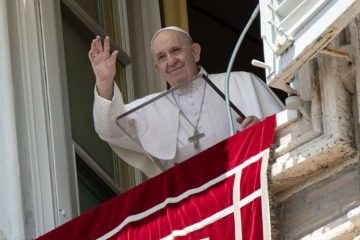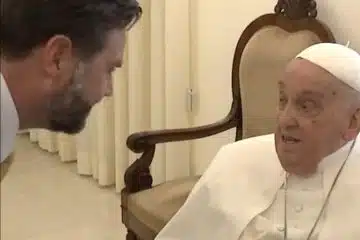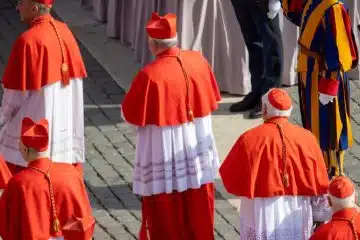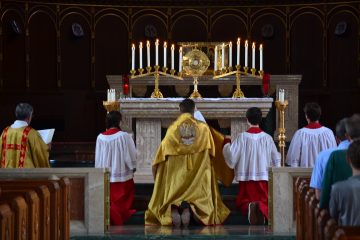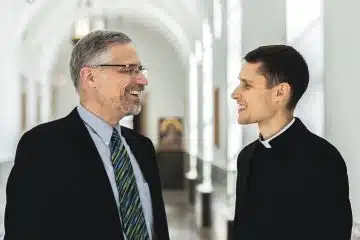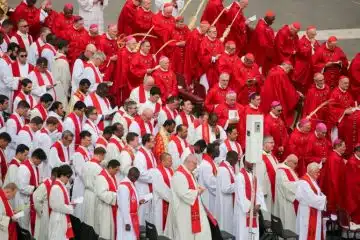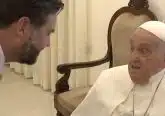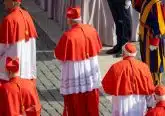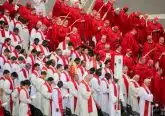Granite and clay: Creativity, patience shape sculptor for priesthood

IMAGE: CNS/Paul Haring
By Carol Glatz
ROME (CNS) — In the small dormitory room that smelled of moist modelling clay, dozens of statues of a laughing Jesus lined wooden shelves against a wall.
The small plaster statuettes showed the Lord reclining on the ground against a rock, his eyes pinched tight and his hand on his chest, which was inflated with a hearty hoot.
“As students become deacons, I give them one,” said Edward Gibney, 54, a Canadian seminarian and sculptor from Saskatchewan. He was preparing to be one of nine men ordained to the diaconate in the Basilica of St. Paul’s Outside the Walls June 15.
“It doesn’t say in the Bible, but I believe he laughed,” he said, explaining his motivation for the “Laughing Jesus” motif, adding that the unguarded moment of mirth shows “the human side of Christ.”
While the souvenir statuettes were ready to go, Gibney was still putting the finishing touches on a bust of Msgr. Roderick Strange, the former rector of Rome’s Pontifical Beda College, which is a seminary for older men run by the Catholic bishops of England and Wales.
“I keep saying it’s pretty well done,” he told Catholic News Service in early June. But he confessed he has a hard time knowing when to put away the tools as he shaved a bit of soft Plasticine from under the eyes and padded the upper lip with a bit more of the dark gray clay.
An old sculpting professor, he said, used to compare finishing an art piece to raising children and realizing, “OK, they’re old enough and ready to go out on their own.”
It’s the same teacher Gibney pays homage to with his mustache. He said he was asked to show up at the professor’s retirement party 20-plus years ago pretending to be a long-lost relative of Spanish surrealist Salvador Dali. He kept the iconic look going when the professor passed away soon after.
So many years spent as a professional sculptor — often working in contemplative solitude and patiently shaping a fluid form from hard stone — gave him insights he believes will be valuable as a priest.
Though a person’s soul is not anything like a chunk of clay or rock, caring for “people’s eternal life is something that takes time, it takes an understanding of people” and patiently uncovering what they need, he said.
A pastor needs to be creative because there is no “cookie cutter” answer or response valid for everyone and the priest needs to recognize his own limitations, “to recognize what you can do” or not.
Though he still has another year of studies in Rome before priestly ordination back in the Diocese of Saskatoon, Gibney said he hopes that he will be able to practice at bit of his craft at different parishes just as he found a way to continue his artwork during his studies.
The Beda College, where he has completed his third year of studies, has been extremely accommodating, Gibney said, letting him use an extra room furnished with a small sink as his makeshift studio. He repurposed a gutted metal desk frame for his sculpting stand and mounted circles of particle board together for the banding wheel.
Back in Saskatoon, he produced many works of religious art, including a large granite representation of the baby Jesus, Mary and her aging mother Ann for the St. Ann’s senior citizens’ home.
Seeing how God was “working with me in my studio” and recognizing “he’s working with you all the time in everything you do” was a key part of his vocational discernment process, he said.
Making art is a form of evangelization, Gibney believes.
When he was finishing the outdoor granite piece for St. Ann’s, for example, the sounds of carving and sanding drew people from the community to come out and watch him work. Questions and conversation followed, he said. “I became the entertainment for about three months. It was lovely.”
When he’s a priest, he said, he would imagine taking whatever free bit of time he finds to throw on his work jeans and — as a sort of sculptor-priest’s version of ringing the church bells — “pound on a piece of granite.”
“That does get people’s attention.”
People then get a better idea of what a priest is, he said. “A priest isn’t just that guy who wears the collar and you see him only once a week on Sunday. He is part of the community and he is trying to contribute to the good of the community,” Gibney said.
“That’s opening the church,” he said, showing that the priest is there to serve everyone in the community. “Catholic or not, they are part of the flock” and Christ, through the priest, is out there with them.
– – –
Follow Glatz on Twitter @CarolGlatz
– – –
Copyright © 2016 Catholic News Service/U.S. Conference of Catholic Bishops. www.catholicnews.com. All rights reserved. Republishing or redistributing of CNS content, including by framing or similar means without prior permission, is prohibited. You may link to stories on our public site. This copy is for your personal, non-commercial use only. To request permission for republishing or redistributing of CNS content, please contact permissions at [email protected].



